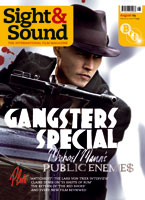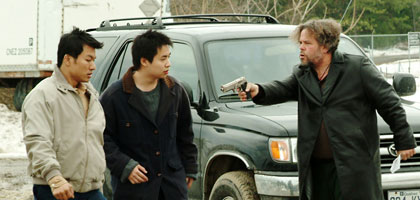Primary navigation


A bleak tale of people-smuggling in the icy terrain of the US/Canadian border, Courtney Hunt's Oscar-nominated Frozen River exemplifies US indies' new concern with the lives of the poor, argues Ryan Gilbey
If the dismal economic climate has any positive effect on storytelling in US cinema, it will lie in bringing to the forefront a previously obscured underclass whose membership is ballooning. They're called the poor. Little Miss Sunshine, with its emphasis on the daily practicalities of low-income living, felt like a welcome anomaly when it was released in 2006, even if it was only rehearsing on film advances made in television by the blue-collar sitcom Roseanne. But the trend towards unsweetened depictions of hardship is now gaining momentum - Wendy and Lucy and Sugar being two outstanding recent examples - and has in the way of these things begun inspiring newspaper think-pieces. That said, the movement will need a catchier name than 'Neo-neo-realism' if it is to have its day in the sun.
Courtney Hunt's debut feature Frozen River joins this burgeoning group by virtue of its blunt depiction of life on, and below, the breadline: this is full-on, popcorn-for-breakfast, combing-the-couch-for-dimes poverty. The film has in its favour a larger than usual share of distinctive elements. There is the subject of people-smuggling, viewed provocatively from the smugglers' perspective. There is the glacial and visually striking setting of Massena, New York State, on the Canadian border close to a Mohawk reservation beyond the jurisdiction of state police. Best of all, there is the actor Melissa Leo, a regular on the well-regarded 1990s television series Homicide: Life on the Street. She plays Ray Eddy, a newly single mother (her gambling-addicted husband just took off with savings earmarked for their new home) who is two years into a dead-end job at a tacky mini-mart.
No wonder Ray is receptive to the offer of earning extra cash by stowing illegal immigrants in her car boot and ferrying them into the US from across the border. The pick-up point is most easily reached by driving, carefully, across the frozen St Lawrence river. What are the chances that both this waterway and Ray herself will have thawed by the end of the movie?
Accompanying Ray on the treacherous runs is a Native American woman, Lila Littlewolf (Misty Upham), who has a chequered past of her own. Her husband drowned on a smuggling run. Their infant son was snatched from her hospital crib by her mother-in-law. And she has been collared by the law before, which is why the local car dealership won't sell her a vehicle with a push-button boot, the easiest kind for smuggling. The film is full of such details that hint at the research Hunt undertook before writing her script (which began life as a short with the same lead actors). We also learn that illegal immigrants are deprived of their footwear before the drive into the US, to stop them absconding at the other end before they've had a chance to work off the many thousands of dollars they owe to the unscrupulous 'Snakehead' gangs who have arranged safe passage.
One hesitates to ask for more from a film that already feels over-burdened with incident, but a few morsels of information about the immigrants Ray and Lila are transporting would have been invaluable. As it stands, they function as commodities not just to the smugglers and Snakeheads but to the film itself, which ventures into their lives only when some increase in suspense can be engineered, or some insight into the main characters facilitated. In an episode which comes halfway through the picture but feels more like a climax, Ray discards on the ice a hold-all belonging to the Pakistani couple who are in her car boot - she grumbles that it might be a bomb. In fact, the bag contains a sleeping baby, and Ray and Lila are forced to retrieve it after first unloading the distraught parents at a motel. So we have a poor and desperate married couple taking refuge at an inn, and a newborn infant in peril. By a strange quirk of fate, or scriptwriting, it happens also to be Christmas Eve.
As that sequence makes clear, Hunt is not afraid to go gunning for tears. At times she shows her inexperience with a little too much telegraphing of plot points and subtext, the sure sign of a director not yet confident in her ability to convey information, or in her audience's ability to interpret it. The poster advertising 'High Stakes' outside the bingo hall where Lila works is laying it on a bit thick. So too is Peter Golub and Shahzad Ali Ismaily's twanging guitar score, straight from that collection much loved by Sundance audiences - Now That's What I Call an Indie Soundtrack, Volume 1. There is also a broken-down carousel outside Ray's home, which is just begging to be spruced up and brought back into action in the final reel.
On top of that, there are scenes that make no sense dramatically. A trooper pulls Ray over about a broken tail-light, then calls at her home the next morning to tell her that Lila is a bad apple. But it's Christmas Day, for goodness' sake: where's the urgency? And it's strange that Hunt ends the film with an irrelevant scene in which Ray's son T.J. gives a shrugging apology to a woman he duped in a credit-card scam. Hard to believe that this one survived numerous script revisions, and the helpful criticisms of friends and loved ones.
These shortcomings don't detract from the sensation that Frozen River is an American Ken Loach film, with both the naturalism and the manipulation that entails. Loach always manages to create a consistently gritty milieu, and Hunt has that down pat too. Even when we can't quite believe what we're seeing, we never doubt the environment in which it is happening. You can feel the salty authenticity in an exchange between Ray and T.J. in which the boy suggests his father took off because “he didn't like getting shot in his own home.” “That was an accident,” Ray responds, bristling with irritation. (She might be talking about a wine stain on the carpet.) Guns are generally shown to be as much a part of life as snow shovels. One clever piece of framing has Ray shooting at Lila's trailer door, without the camera first revealing that she has drawn, or even owns, a weapon. The effect is both to deny the firearm its traditional fetishisation, while paradoxically making its casual use all the more disturbing. It ensures too that the moment when Ray has to pull the gun on an adversary, to defend herself and Lila, is stripped of any Thelma & Louise-style titillation. It's just business.
As Ray, Melissa Leo must take at least as much credit for the film's successes as her director. She isn't merely tough as old boots - she makes old boots look like ballet shoes. Hunt's camera savours every inch of her: the tattooed toes, pink fleece housecoat, hurricane hair and saddlebag skin are incorporated in one slow tilt up her body as she drags on a dawn cigarette. The shot ends on her face as she concedes a grudging tear; that close-up, like a later one in which she applies eyeliner between sobs, establishes character succinctly and forcefully. It gives the lie to the notion that cinema can't compete with the literary device of the interior monologue.
Leo was the wild-card entry in the Best Actress category of this year's Oscars, and though she was never going to win, the recognition was significant. (Hunt also got a nod for the screenplay.) The challenge for this uncompromising performer, now she has moved up several pay grades, will be to fend off unimaginative casting directors who see her only as first choice to play Tart with a Heart, Plucky Best Friend or Hero's Devoted Wife.